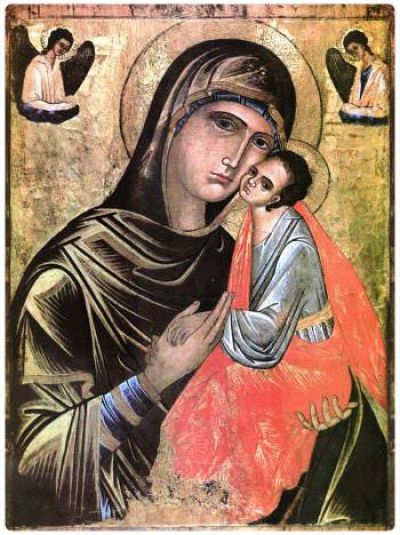Il Santurario della Madonna di Custonaci, patrona di diversi Comuni staccatasi da Erice, raccoglie oggi l’identità del popolo dell’agro-ericino ed è stato per secoli meta di pellegrini venuti ad omaggiare la Madonna arrivata dal mare, secondo la tradizione, su una nave veneziana o francese scampata ad un naufragio e approdata a Baia di Corino. Tale evento viene rievocato il lunedì antecedente l’ultimo mercoledì di agosto, durante i festeggiamenti in onore della Madonna, con l’arrivo di un veliero e lo sbarco di una copia del quadro nella stupenda cala illuminata dai fuochi pirotecnici e alla presenza di numerosi fedeli, molti dei quali, armati di fiaccola accompagnano in processione la sacra immagine fino al Santuario. Nelle acque antistanti si trova “Stella Maris”, una statua raffigurante la Madonna di Custonac, appoggiata sul fondale marino e “omaggio alla Madonna Madre Nostra Santissima in memoria delle Donne, delle Mamme e dei loro Cari che, in mare hanno perso la vita in cerca della Libertà”. Si legge così, nella targa posta sulla base dell’incantevole statua rivolta volutamente verso il mare, mentre il meraviglioso volto di Maria guarda la sua Terra speranzosa di un futuro di fede, amore e rispetto. Il volto di suo figlio Gesù guarda il cielo verso Dio.
According to legends, a myriad of la Madonna images has miraculously arrived in Italy – via the sea – for centuries. Prior to La Madonna arriving in Custonaci, Sicily, many other Italian towns were graced by her mysterious arrival.
No one knows when the venerated Byzantine “Madonna Greca” image arrived in Isola a Capo Rizzuto in Calabria. According to ancient legend, a Calabrian shepherd found the sacred icon while grazing his sheep near the beach. Legend dates the arrival of “la Madonna della Madia” by raft into Monopoli in Puglia in the early 12th century. Three hundred years later, another pugliese Byzantine Madonna, “Santissima Maria della Libera,” beached on the Rodi Garganico shore.
Countless miracles have been attributed to the beloved 14th century “la Madonna che viene dal mare” (“the Madonna coming from the sea”), found on a Salerno beach, having floated in from a sunken ship coming from Constantinople. The “Madonna della Civita,” painted on wood in the 8th century, was locked in a wooden coffin and miraculously beached off Gaeta, south of Rome, after 54 days floating around the Mediterranean. She had been “launched” off Messina, Sicily by devout monks trying to save her from invaders. Another Sicilian Madonna, “la Madonna dell’Angelo” of Tindari, was hauled out of the sea in fishing nets in the 16th century and Lampedusa’s Madonna arrived on the island from the sea about the same time.
A century earlier, near Custonaci on Sicily’s west coast, a French ship returning from Alexandria, Egypt, seeking refuge from a furious storm, headed into the nearby cove, Cala Bugato. Miraculously, thanks to an image aboard of the Virgin nursing the Christ Child, “La Madonna del Latte” (“Our Lady of the Milk”), all the sailors were saved. The grateful seamen carried the Madonna ashore and promised to build a sanctuary there in thanks.
Over the centuries, the early 15th century ex-voto (a vow of thanks for a favor received) chapel for the Madonna was enlarged into a magnificent santuario mariano (a shrine dedicated to Mary). Maria Santissima di Custonaci was adorned throughout with the stunning veined marbles of the Custonaci area, an area known for its marbles and called “la riviera del marmo.” Embellishments on the shrine continued right up to the last century with the addition of the noble staircase and entranceway of intricate stonework.
Today, in late August, children play on the church steps during the festivities in the Madonna’s honor. Just below, Custonaci’s main street festoons with white lights overflowed with strolling couples and families enjoying gelati at outdoor cafes while the lively music of a brass band plays in front of the Sanctuary. At the other end of the pedestrian walkway, a local youth orchestra plays. The youthful musicians accompany the children’s choir, little ones singing their hearts out – maybe not always in key – for la Madonna. The celebrations go on for four days, culminating in the re-enactment of the arrival of “la Madonna Santissima di Custonaci” (a replica as the Madonna never leaves the Santuario) on an ancient boat, other fishing boats surrounding her, creating a sort of maritime procession. Sailors in period dress bring the image ashore, the bishop there to bless it, thousands of the faithful from all over Sicily awaiting on the shore and then following the stonemasons bearing Her in solemn procession to the Custonaci sanctuary.



